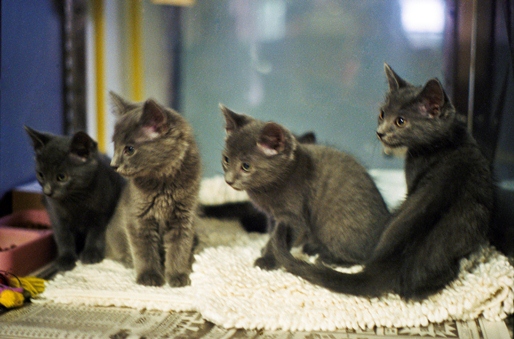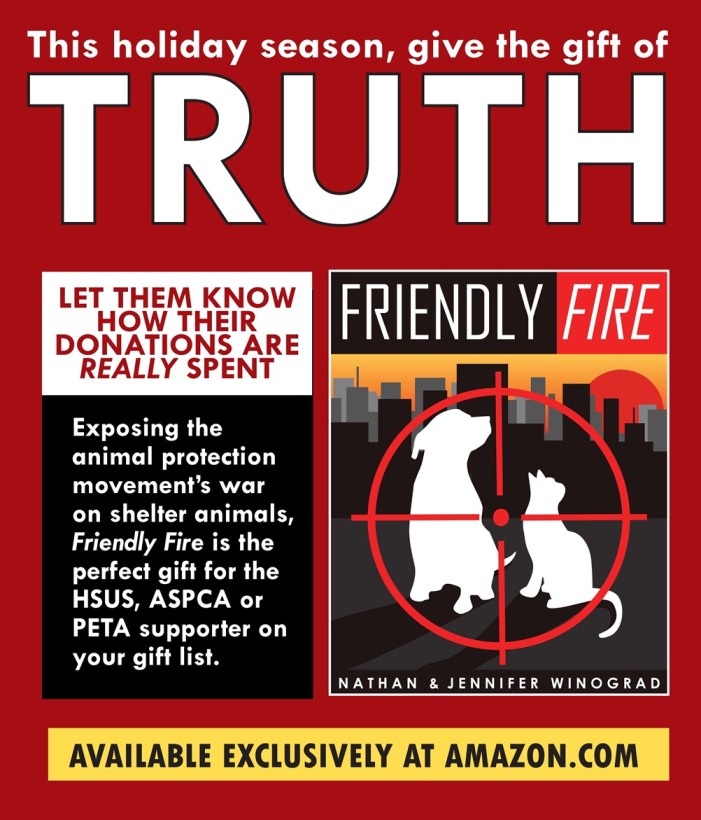
Excerpted from Friendly Fire by Nathan & Jennifer Winograd.
In 1998, California legislators held hearings on whether to make it illegal for shelters to kill animals when non-profit organizations were offering to save them. Some legislators were confused, asking why shelters would want to kill animals who have an immediate place to go. The answer, of course, was power. The legislation threatened to open up shelter killing and other atrocities to public scrutiny. As frequent visitors to the shelters, rescuers saw systemic problems and inhumane treatment, but their access to animals was tenuous and many times hinged on not publicly disclosing concerns. Under the pending legislation, their right to rescue would no longer be legally premised on silence as to inhumane shelter practices. The law, in effect, would create a desperately needed whistleblower provision and allow rescuers to go public without fears of retribution, as evidenced by what one rescuer faced before the law went into effect:
I went to the shelter because I was told they had a mother cat and four kittens that they had scheduled to be killed even though they were healthy. When I arrived to pick up the cat and kittens, the shelter manager asked to see me. She told me that a member of our rescue group wrote a letter complaining about the shelter to the Board of Supervisors and that they didn’t appreciate it. She told me I could therefore only have one kitten. I begged her to let me take them all, but she said that I couldn’t. She told me to pick one and she was going to euthanize the rest, including the mother cat. I didn’t know what to do. And so I picked. My hand was shaking as I filled out the paper work. After I got the kitten, I went outside and sat in the car. Then I threw up all over myself.
Had the California law which has since saved hundreds of thousands of lives been in effect when this rescuer arrived at the shelter she described, its manager would not have been allowed to deny her the right to adopt those animals nor would she have had the ability to emotionally torment the rescuer by forcing her to make a choice that would haunt her for the rest of her life. Stories like these are, in reality, tragically commonplace. When rescue access legislation was pending in New York and Florida, studies found that roughly half of all rescuers routinely look the other way at animal neglect and abuse in shelters for fear of losing their ability to rescue should they ever express their concerns. Other rescuers who did go public told of shelter employees retaliating by killing animals they had offered to save.
These actions were intended to wound people who have expressed concern for the animal victims of shelter neglect, abuse and killing. Day in and day out, these rescuers show tremendous courage and compassion—visiting a place that is hard for animal lovers to go: their local shelter. And yet they go back, again and again. They endure the hostile treatment. They endure the heartbreak of seeing the animals destined for the needle. They endure having to jump through unnecessary and arbitrary hurdles set by shelter directors who are holding hostage the animals they want to save. They endure having to look the other way at abuse of other animals, because if they don’t, if they speak out, they will be barred from saving any animals. And yet efforts to protect rescuers, to empower them to save animals, remain the exception nationwide and many recent efforts to pass legislation mandating rescue access rights have been defeated.
Of course, it is the animals who pay the ultimate price when cruel and vindictive shelter workers retaliate against rescuers, but they are not the only ones who suffer. Retaliatory killing of animals is an effective punishment of rescuers because it hits them where it hurts the most. Rescuers do what they do out of sheer love and concern for the well-being of animals. When a particular animal a rescuer has requested is needlessly killed, it can take a heavy emotional toll on that rescuer, leading to feelings of anger, helplessness and despair. And not only does retaliatory killing deny the rescuer what he or she wants—to save a particular animal—the rescuer is often haunted by guilt, left to contemplate whether in singling out a particular animal or openly criticizing the shelter for neglect or abuse, they are somehow culpable in that animal’s death.

Before Tompkins County, New York, became a No Kill community, the volunteers at that shelter had complained to an inattentive Board of Directors about poor care, dirty facilities and rampant killing only to have those complaints dismissed and ignored. For years, volunteers had to endure the knowledge that animals in their community shelter were being routinely neglected, needlessly killed and at the mercy of a shelter manager so lacking in compassion that she once killed a puppy with muddy paws who jumped up to greet her and soiled her skirt. Another volunteer told of how she had stopped volunteering after two motherless kittens whom she had fostered for the shelter were killed when she returned them to be adopted. Although she had tenderly cared for each of the kittens over the course of several weeks, and though she had told the shelter to let her know if they were ever in any danger so that she could take them back, they were killed without anyone ever calling her:
I checked the logbook to see when they were adopted. Instead, I was stunned to learn that two of them had been killed. I never even received a telephone call or an email asking that I take them back. They had been perfectly healthy and loved and wanted, and they had a place to go if the shelter ran out of room. I felt sick. The room began spinning. I was in tears. I’ll never forget the looks of shock on the faces of the other volunteers. The staff didn’t budge. One other volunteer was concerned and tried to stop me from leaving, but I fled the building and somehow managed to bike the several miles home, even though I could barely see for crying.
Nor was her experience out of the ordinary. Many of the volunteers at the shelter were forced to endure emotional hardship in order to help animals. Although these were individuals who volunteered their free time out of love, they were treated with neither gratitude nor respect, but rather resentment and contempt. While lazy, uncaring employees smoked cigarettes and socialized, it was the volunteers who cleaned the cages, fed the animals, counseled potential adopters and, when staff members who had forbidden them to enter the isolation ward weren’t looking, administered medication to sick animals who otherwise would have never received it. With their expectation that animals should be kept in clean cages, be given fresh food and water, be socialized, walked, given every opportunity to find a home and be otherwise well-cared for, volunteers found themselves at odds with an organization that resented their “interference.”
These attitudes expressed themselves through petty vindictiveness and arbitrary displays of power that not only caused needless animal suffering, but created a climate of fear and intimidation that caused volunteers stress and anxiety not just for the animals, but for themselves and each other as well. “Volunteers are more trouble than they are worth,” said the shelter manager to Nathan shortly after he arrived (a shelter manager he would soon terminate), even though it was the volunteers who did the lion’s share of the work that she and her lazy, uncaring staff refused to. And all of this abuse—to animals, to people and to the citizens of every community whose tax dollars fund local shelters that are run neither humanely nor professionally—comes down to one root cause: corruption fostered by an imbalance of power.
Right now, shelters are the fiefdoms of their directors who can kill almost any animal, almost any time and for any reason. They can exclude members of the community from volunteering. They can prevent other non-profits, such as rescue groups and other shelters, from saving the lives of animals in their custody. And when volunteers or rescuers go public with their concerns, they are terminated. It doesn’t have to be this way.
As a society, we owe a particular debt of gratitude to people who voluntarily offer a helping hand to the needy and that includes our nation’s homeless animals. Animal rescuers and shelter volunteers are compassionate people who open their hearts and homes to provide a safety-net for animals others may have abandoned and whom our dysfunctional shelters betray even further by killing. And yet those who should be celebrating them as heroes—our nation’s animal protection groups—instead denigrate and malign them, paradoxically equating them with some of the cruelest people there are—hoarders and dog fighters—in order to fight legislation that would empower them to overcome shelter directors in community after community who make it impossible to do what should be simple and straightforward—partnering with others to save lives.
Rescue rights and shelter reform laws not only save lives, they foster fairness, respect and consideration for people who both need and deserve it. Animal rescuers and shelter volunteers are already donating their time, their energy, their resources and their love to make our world a better place. They shouldn’t have to sacrifice their emotional well-being, too.
***

To purchase, click here.
—————-
Have a comment? Join the discussion by clicking here.
My Facebook page is facebook.com/nathanwinograd. The Facebook page of my organization is facebook.com/nokilladvocacycenter. Many people mistakenly believe that the Facebook pages at No Kill Nation and No Kill Revolution are my pages. They are not.